
Robinia, false acacia : plant, prune and care
Contents
The Robinia or False Acacia in a nutshell
- Small to medium trees with low shade, robinias are decorative and very easy to grow
- Fast-growing, they make excellent standalone specimens with soft outlines and spectacular clusters of white or pink flowers, fragrant and highly melliferous in May-June
- Highly varied, they come in numerous cultivars, sometimes adopting golden foliage in ‘Frisia’, featuring twisted branches in ‘Twisty Baby’, or having a rounded habit in ‘Umbraculifera’
- With its excellent resistance to harsh conditions (pollution, poor soil, hot climate) and rapid production of rot-resistant wood, the robinia is a quick solution for reforestation
A word from our expert
The black locust, also known as false acacia, is sometimes mistakenly referred to as acacia, with which it should not be confused (the botanical name Acacia refers to Mimosa). This tree, native to North America and introduced to Europe around 1600, has been widely planted in forestry across Europe since the 19th century due to its extremely rapid growth even in poor soil and its durable, rot-resistant wood. It is valued in ornamental gardens for its remarkable flowering towards the end of the 17th century, then neglected, only to regain its popularity a century later, particularly with the arrival of cultivars and new species. The ‘Casque Rouge’ black locust produces bright pink clusters, while the ball-shaped false acacia is an excellent small shade tree with a structuring effect. The ‘Frisia’ variety is very popular for illuminating a scene with its incredible chartreuse foliage that makes a statement in spring, evolving to golden yellow in autumn.
This small tree, naturalised in many places around the world, is also appreciated for the flavour and fragrance of its flower clusters, which are used to make delicious fritters or syrup.
The black locust can be criticised for the thorny character of its branches and its unfortunate tendency to produce suckers, but the cultivars intended for gardens have overcome these drawbacks. They typically form a medium-sized tree ranging from 2.5 to 8 m tall, depending on the cultivars, with light green or golden yellow compound foliage that is suitable for alignment, in groups, or within a flowerbed, even in pots. You can also place it against a backdrop of evergreen bushes or conifers.
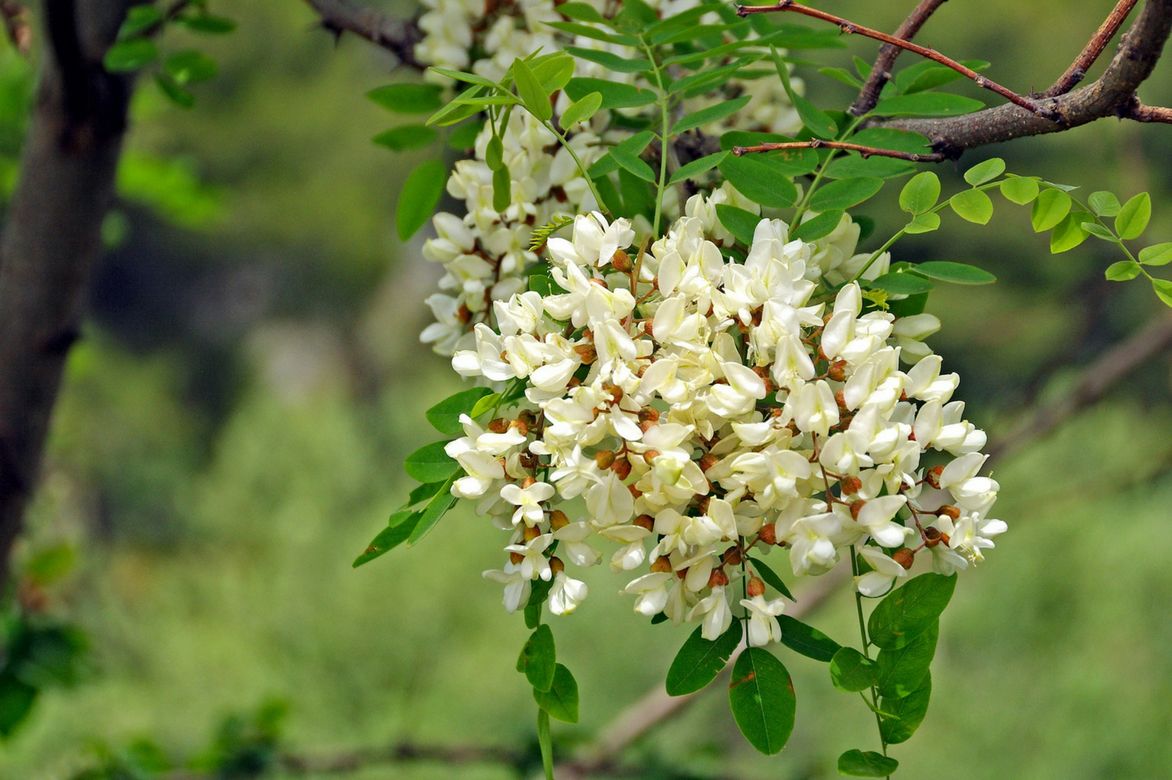
Beautiful inflorescences of Robinia pseudoacacia or false acacia.
Description and Botany
Botanical data
- Latin name Robinia sp.
- Family Fabaceae
- Common name Black locust, ball acacia, rose acacia, twisted acacia
- Flowering May-June
- Height between 4 and 25 m
- Exposure sun
- Soil type all soils, even poor, wet or dry depending on the species
- Hardiness Excellent (-23°C)
The genus Robinia or black locust includes 8 species of deciduous woody plants, all native to the United States and Mexico, characterised by rapid growth (13 m after 20 years in R. pseudoacacia) and a very good tolerance to pollution. Most of them do not exceed 1.80 m in all directions, while the most commonly planted species, Robinia pseudoacacia, can reach 25 m in height with a trunk diameter of 60 cm. They often propagate by suckers and by sowing, which increases their ability to spread. Locust trees belong to the Fabaceae or Leguminosae family, which allows them to colonise poor soils thanks to the ability of a bacterium, Rhizobium, in symbiosis within the nodosities of the tree’s roots, to capture nitrogen from the air and convert it into nitrates. The tree is often planted to combat soil erosion. The black locust lives for about 300 years.
In the black locust, the trunk is quite irregular, with the rounded crown taking on a parasol shape with age. The angular branches are slender, quite brittle, and remain relatively short. In the hybrid Red Galea, resulting from the cross-breeding between R. pseudoacacia and hispida from the southeastern United States, the branches are less sensitive to wind. The buds are barely visible, only lateral and embedded in the bark, in small groups and covered with imbricate scales. The leaf scar, visible after leaf fall, is formed of three lobes or a well-defined triangle. The thorns positioned in the axil of the leaves persist for years and are larger when the tree is young or when the shoot is vigorous. The smooth, brown bark, with lenticels on young trees becomes thick, deeply channelled, and dark as it ages.
The pinnate leaves of the black locust are composed of light matte green oval leaflets that can be confused with those of Sophora. These leaflets, soft in texture, light green in colour, glaucous on the underside, are however pointed at their tips. The leaves of the black locust generally bear spiny stipules at the base of the petiole on the stem. This spiny character is absent in most cultivars and rare in older specimens. In Robinia pseudoacacia, the leaves, 20 to 30 cm long, bear 7 to 21 leaflets that children enjoy stripping by running their hands through them to create a “rain of leaves”. The Robinia pseudoacacia Twisty Baby has its leaflets curling beautifully.
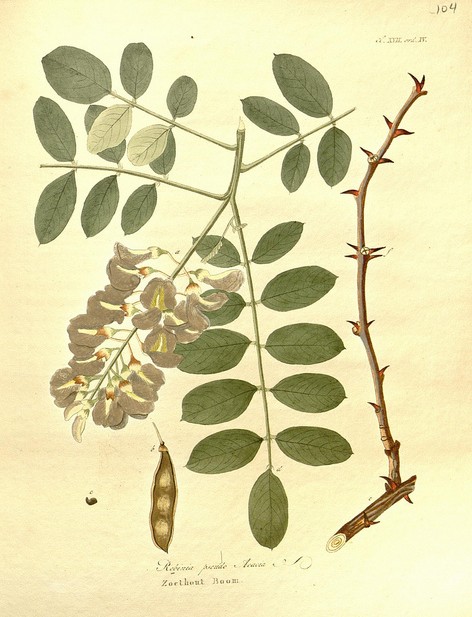
Robinia pseudoacacia – botanical illustration.
The lamina turns butter yellow in autumn but it sometimes happens that the leaves fall before turning yellow, as is the case with many nitrogen-fixing trees.
The pea-like flowers that make up the cluster of about 14 cm long are white and fragrant in the black locust, pink in R. hispida, bright pink in Red Galea, and white washed with pink in the dwarf variety Robinia x slavinii ‘Hillieri’. The clusters of R. viscosa are quite atypical with their light pink colour tinged with pale yellow, which contrasts beautifully with the almost black branches of the tree.
The inflorescences arise in the axil of the leaves, towards the tips of the shoots, and bloom in June, about a month after leafing in the black locust. The flowering of R. hispida often occurs in August-September. ‘Umbraculifera’ and ‘Twisty Baby’ do not bloom or bloom very little. The flowers are very nectariferous, and pollination is carried out by insects, resulting in a highly prized honey.
The fruit is a flat pod measuring 7 to 10 cm, dark brown to reddish, containing hard seeds, enveloped in an impermeable integument, measuring 3 to 5 mm. The seeds remain viable for many years under cool, dry conditions. The production of pods varies from year to year and is abundant only every 2 to 3 years. The pods are grouped in 2 to 4 and ripen in summer. The seeds are consumed by birds and small mammals.
The rot-resistant wood, tinted orange, explains the enthusiasm for the black locust as a forestry tree. It is mainly used to make stakes for vines or even for use in water (oyster parks…), tool handles. It is increasingly used for the manufacture of garden furniture, replacing exotic woods, which is a good thing for combating deforestation. The wood is also a very good fuel. A yellow dye is extracted from its crushed wood. The leaves, with antispasmodic properties, are sometimes used as fodder during dry years, knowing that the branches and bark (emetic and purgative) are toxic to livestock and horses. The active principle contained in the bark is robin, a haemagglutinating and mitogenic lectin, while in the leaves and seeds, it is robinin. The fragrance of the flowers is used to create perfume or flavoured wine. They have calming, astringent, and tonic properties.
 Robinia pseudoacacia: flower clusters (Andreas Rockstein), seed pods (Andreas Rockstein), leaves (Virginie Douce), thorns (Rudolf Schäfer).
Robinia pseudoacacia: flower clusters (Andreas Rockstein), seed pods (Andreas Rockstein), leaves (Virginie Douce), thorns (Rudolf Schäfer).
Beware of the invasive character of the black locust. Its very rough thorns lead to the formation of dense and impenetrable thickets.
The main varieties of Robinia
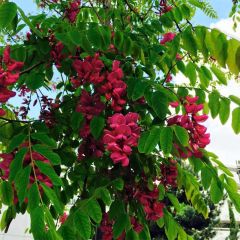
Robinia pseudoacacia Casque Rouge - Black Locust
- Flowering time June, July
- Height at maturity 8 m
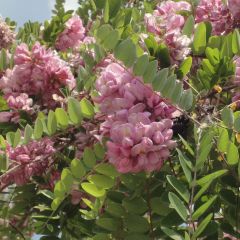
Robinia hispida Rosea - Rose acacia
- Flowering time June to October
- Height at maturity 2,75 m
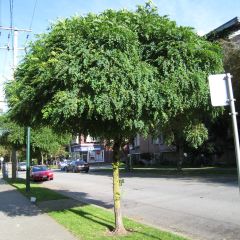
Robinia pseudoacacia Umbraculifera - Parasol Acacia
- Height at maturity 5 m

Robinia pseudoacacia Twisty Baby Lace Lady - Black Locust
- Flowering time June
- Height at maturity 4 m
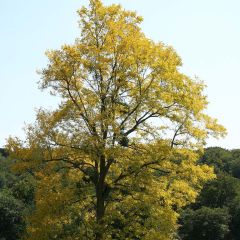
Robinia pseudoacacia Frisia - Black Locust
- Flowering time June, July
- Height at maturity 8 m
Discover other Robinia - Black Locust
View all →
Available in 3 sizes
Available in 4 sizes
Available in 2 sizes
Available in 1 sizes
Available in 1 sizes
Available in 1 sizes
Available in 1 sizes
Available in 1 sizes
Available in 2 sizes
Available in 1 sizes
Planting the false acacia
Where to plant the Robinia?
The false acacia grows in all French regions below 700 m in altitude. This tree is quite hardy, tolerating cold temperatures of around -23°C. It thrives in full sun, sheltered from strong winds and sea spray as its branches are brittle and the wind can damage its flowering. The robinia pseudo-acacia prefers loose, cool soils such as those along banks that are moderately dry, slightly acidic to alkaline. It dislikes very chalky soils and overly compacted clay soils that suffocate the roots during the wet season but is content with sandy or gravelly, dry and poor soils.
All species tolerate urban pollution, making them excellent alignment trees, suitable for modest-sized gardens with trees not exceeding 8 m in height and 4 m in width, or for container cultivation with dwarf forms.
When to plant?
Plant the Robinia preferably in autumn to ensure deep rooting before facing summer drought.
How to plant?
Allow sufficient distance according to the species of robinia. The ball-shaped robinia reaches up to 5.50 m and its crown extends up to 4 m. It does not age well following severe and repeated pruning. The false acacia ‘Frisia’ will average 8 m in height with a spread of 4-5 m and has a very good longevity. ‘Twisty Baby’, with a growth rate of over 50 cm per year, has entirely twisted foliage and reaches up to 4 m in height with a spread of 3 m.
- Soak the root ball in a bucket of water to thoroughly moisten it.
- Dig a planting hole, 50 cm in all directions.
- Add a 10 cm drainage layer (gravel, sand…) if your soil is clayey.
- Place the plant in the planting hole.
- Replace the soil and lightly firm it down.
- Water.
- Spread a layer of mulch at the base to maintain good moisture around the roots. This will also limit the growth of weeds.
Recovery is easy and quick, requiring only monitoring of watering during the first 2 years following planting.
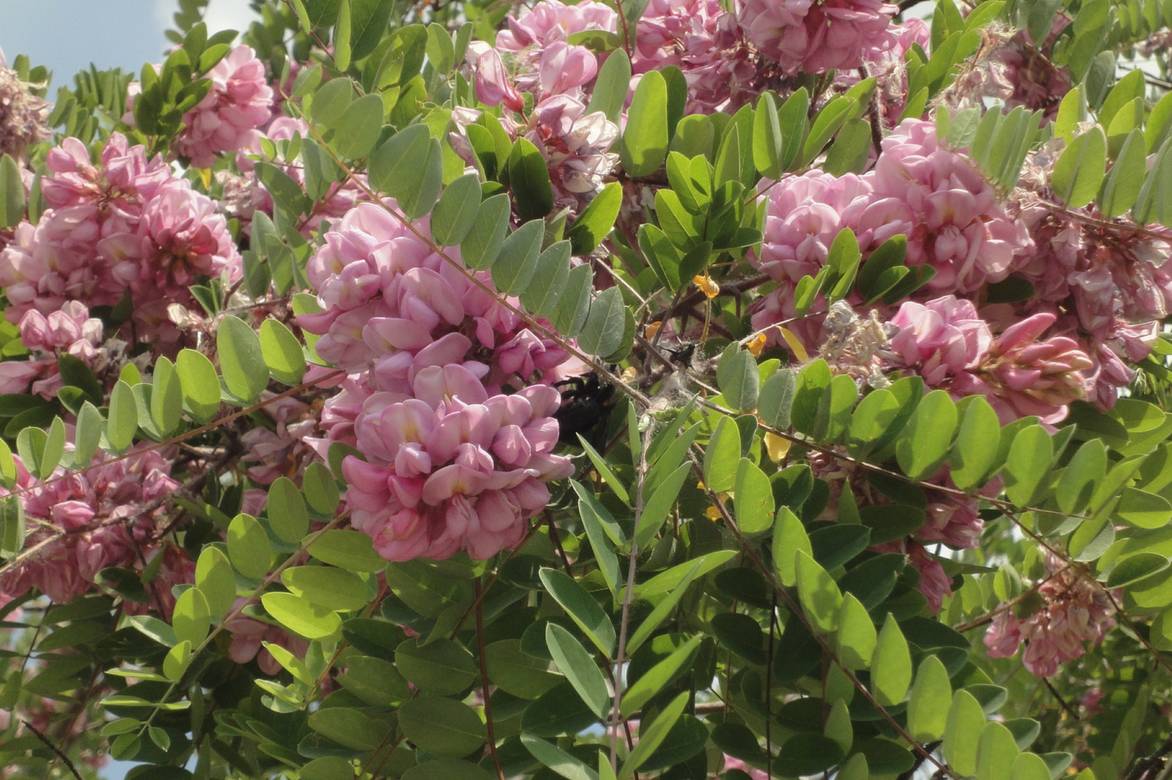
Pink inflorescences of Robinia hispida ‘Rosea’.
Read also
Birches: planting, pruning and careCare and pruning of the black locust
Water regularly for the first two years, especially during hot and dry periods. This bush requires no other maintenance.
Pruning is neither useful nor recommended as the wood scars quite poorly and the branches do not elongate much. Simply prune dead or weak wood in summer (from August to October) to avoid sap flow. Apart from the ball or contorted varieties, remove branches that cross inside the ramure to maintain an airy habit.
Be cautious of voles that are very fond of bark and attack the base of plants. Protect the trunk of young plants with a protective filament if necessary.
Multiplication
Robinia multiplies easily by sowing or by division of suckers in wild species, particularly in Robinia pseudoacacia, which is classified as an invasive plant in certain regions. Cultivars can be propagated by cuttings or grafting. The cultivar Robinia pseudoacacia ‘Umbraculifera’ is, for example, grafted 2 m above the ground onto the species type to obtain a trunk. Sowing is possible but does not produce identical subjects to the mother plant, knowing that flowering occurs only after 10 years when the variety is capable of flowering.
Propagation by Cuttings
Prepare a pot deep by filling it with potting soil mixed with sand, or carry out your cuttings in the ground if it is light, after aerating it with a fork, then moistening it.
- Take a lignified shoot 10 cm long from a current year’s shoot that is still green but hardened at the base.
- Remove the leaves near the base of the cutting, and cut the others to reduce the leaf area.
- Insert the cuttings into the soil to 2/3 of their height, ensuring they do not touch each other.
- Gently firm the soil around to eliminate air pockets and ensure good contact between the potting soil and the cutting.
- Place them in a humid environment in the shade, for example, by covering them with a cut transparent plastic bottle.
- At the end of September, remove the bottle and place the culture under a frame until spring.
- Separate the rooted cuttings in spring to plant them in individual pots until the following autumn.
Sowing
Sow after scarifying the seeds with sandpaper in autumn or spring.

Seeds and sowing of Robinia pseudoacacia.
Uses and associations
Apart from practical uses on poor or polluted soils for their rehabilitation, such as embankments, former landfills, or mines, robinias can hold a prominent place in the garden with cultivars selected for specific qualities. However, avoid planting them near nature reserves.
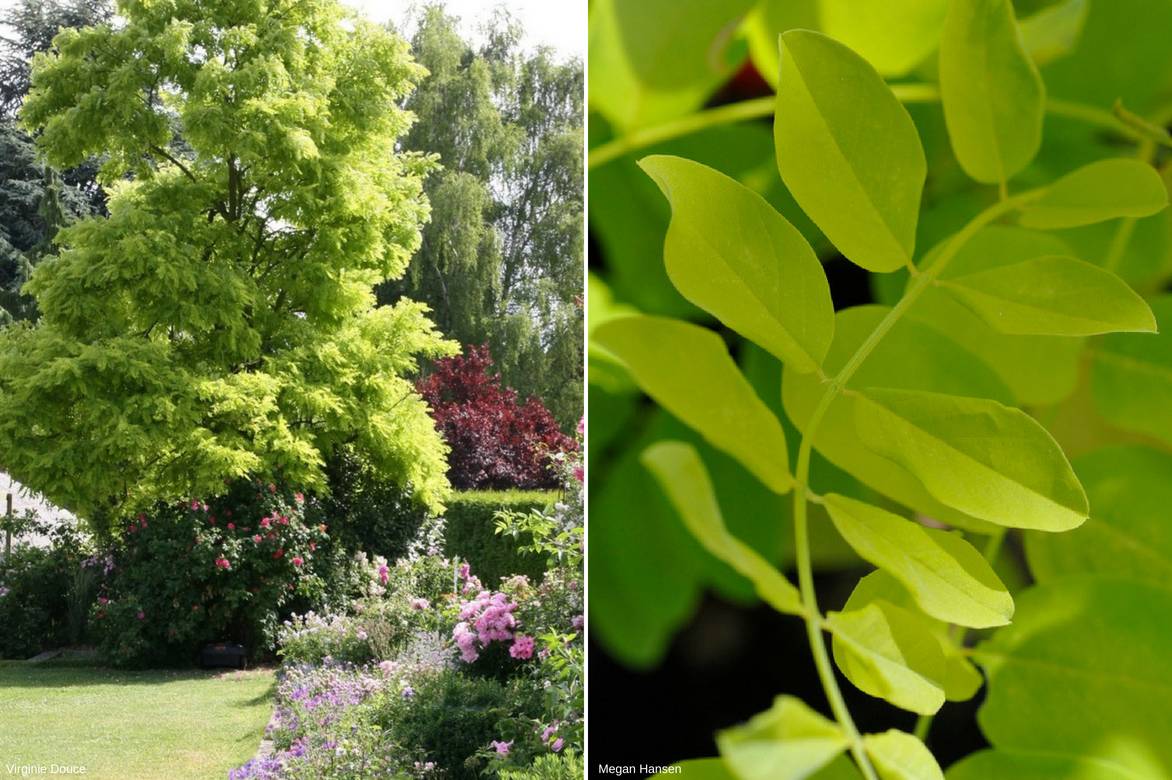
An example of use: Robinia pseudoacacia ‘Frisia’ brings a lot of light among the roses. Accompany the roses with nepeta, hardy geraniums, mulleins, poppies, stachys… for a rustic feel.
The Robinia, depending on the variety, is suitable for both small and large gardens. It naturally finds its place in a flowering or defensive hedge, or as a specimen tree, like the cultivar ‘Tortuosa’, which boasts a beautifully twisted silhouette. With its delicately cut, light foliage made up of leaflets, the Robinia makes an excellent shade tree: it filters sunlight in summer and returns light in winter. It is often seen as an ornamental tree along avenues.
You can place it against a backdrop of evergreen shrubs or conifers (cypress, thuja, yew, junipers) or integrate it into a flowering grove in poor soil, alongside other low-maintenance and highly ornamental trees or shrubs such as Sophora davidii, red oak (Quercus robur Purpurascens), purple hazel, as well as other less vigorous Fabaceae like Laburnum cytisus, Indigofera gerardiana, Colutea arborescens, and coronilla… Remember to plant these species at the same time so that the robinia remains dominant and is not overshadowed by them.
Dwarf forms like ‘Twist Baby’ can accompany shrubs such as Mexican orange, Physocarpus, Weigela, or flowering or foliage-coloured perennials (Phlox, Asters, Heuchera, Phormium, grasses…).
Did you know?
The wild species of acacia, valued for its ease of cultivation, the quality of its wood, and its very rapid growth, is however not recommended for a garden or for mass planting near cultivated fields (especially in agroforestry) or meadows due to its strong tendency to sucker and its relative toxicity. Planting by a riverbank or in a thicket can be considered. The suckers that can emerge more than 40 m from the tree form large thorns and require regular control to eliminate them. The felling of an adult specimen often leads to the appearance of numerous suckers. Prefer the Japanese Sophora for its atmospheric nitrogen-fixing effect. The species is considered invasive in Europe and Japan, which does not prevent its continued planting! It thus competes with local flora, alters soil quality by incorporating nitrogen, and forms dense thickets that can be impenetrable at times.
There is a specimen of false acacia aged 400 years in the heart of Paris – in the Viviani square – which is considered the oldest tree in the city. It was planted in 1601 by Jean Robin, the King’s arborist and apothecary, who is said to have received seeds from the English nurseryman John Tradescant the Elder, who was responsible for its introduction to France.
The Ark of the Covenant is said to have been made of acacia wood covered in gold, and Christ’s crown from its woven branches. Among Freemasons, acacia symbolises the love of God, associated with the legend of the builder of Jerusalem.
The word Acacia originates from the Greek word akakia, which means “innocence, simplicity” and originally referred to the fruit of the robinia. In 19th-century slang, it took on the meaning of “a worker hauling boats” in the port of Le Havre and appeared in the expression “to do one’s acacias,” meaning “to stroll in style,” preferably along the Porte-Maillot to the Concorde. The name Robinia honours the gardener of King Henry IV, Jean Robin, who first planted it in France.
To go further
Discover our wide range of Robinia pseudoacacia.
- Subscribe!
- Contents
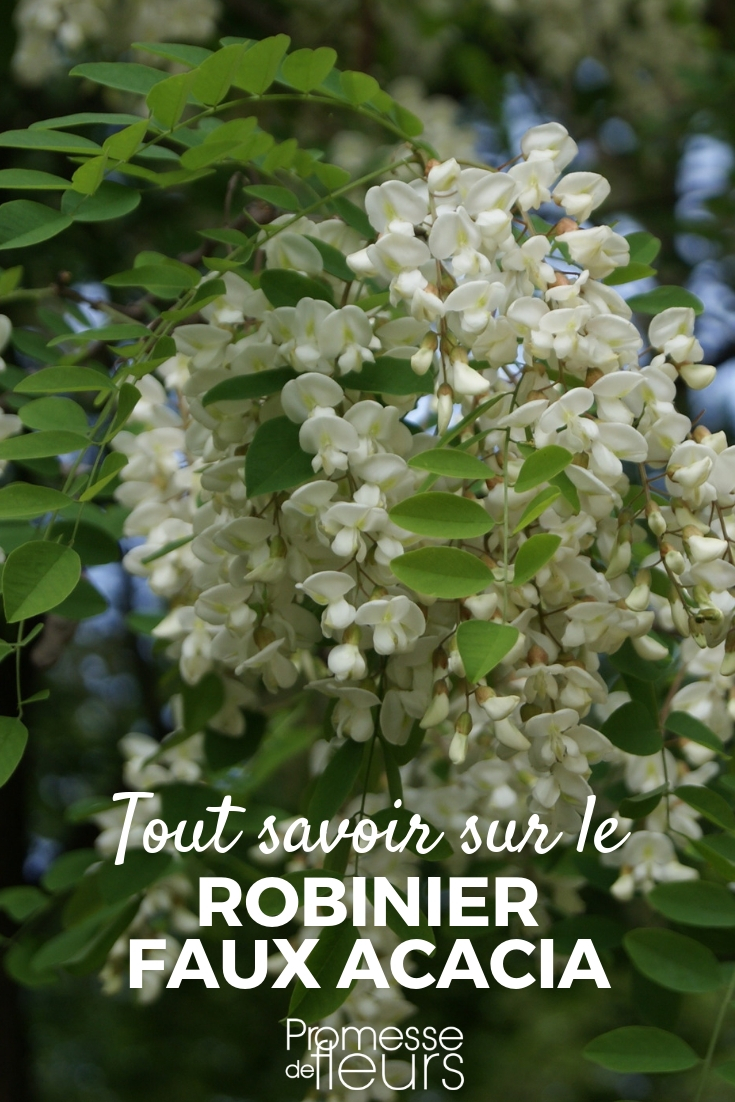































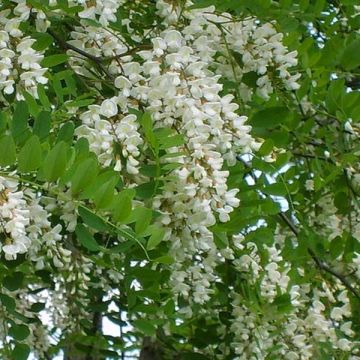

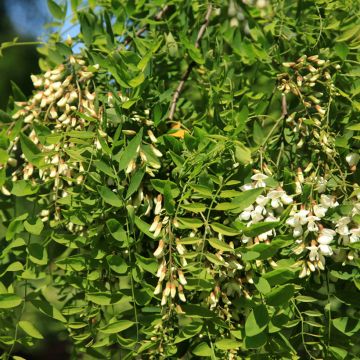
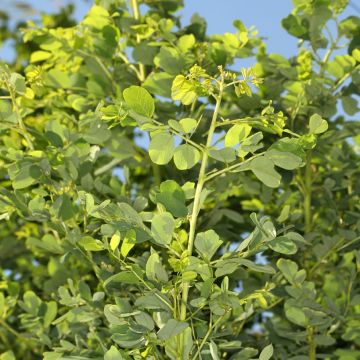
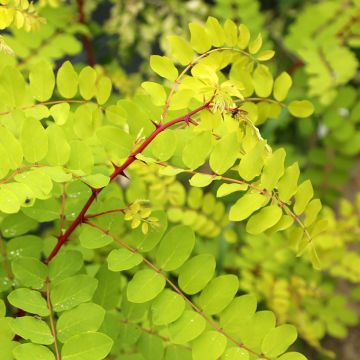
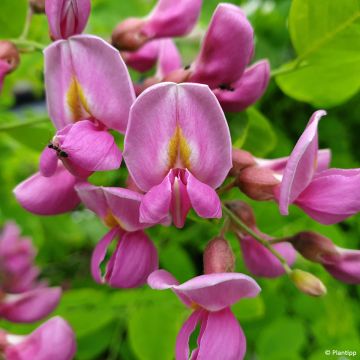
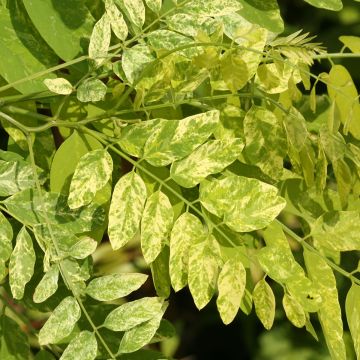
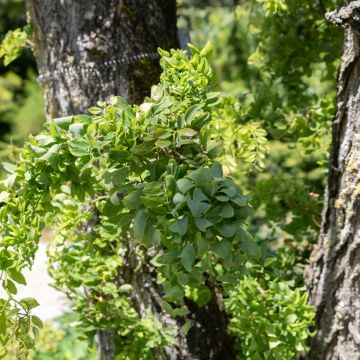

Comments